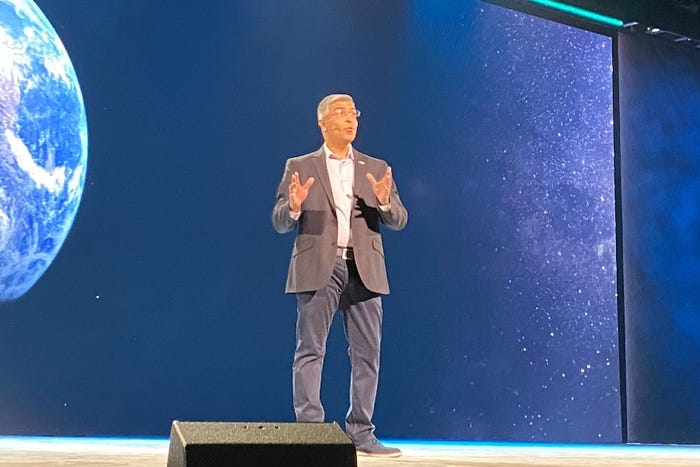The cybersecurity industry can't wait until a cyber pandemic to transform security.

RSA CONFERENCE USA — The theme of this week’s RSA Conference USA, the first live one since the start of the pandemic, is transformation across the cybersecurity industry.
Rohit Ghai, RSA‘s CEO (pictured above), gave the opening keynote detailing the meaning behind the theme. RSA Conference USA has drawn tens of thousands of attendees from across the globe to San Francisco.
Ghai asked if the cybersecurity industry is really going to wait for a cyber pandemic to transform security.
“Transform, we must,” he said. “Our survival depends on it.”
Cybersecurity needs to reframe its roles with security, convenience and innovation, Ghai said.
“We need to ditch the dogma of cyber,” he said. “Identity is the No. 1 constant. The truth is what matters most. And we need to stop thinking of security and convenience as a constant trade-off.”
Beyond the keynotes, RSA prompted a flurry of latest news from IBM, Perimeter 81, Skyhigh Security and more.
Moving Past Sunburst
In addition, SolarWinds was on hand to give an update on its progress since the Sunburst supply chain attack rocked it in late 2020 and well into 2021. Jeff McCullough, SolarWinds’ vice president of global partnerships, said the company has bounced all the way back and has even more to offer partners. He took this role with SolarWinds last November.
Since Sunburst wreaked havoc on SolarWinds, the company has focused heavily on transparency, McCullough said.
“We took the opportunity to really lean into how we improve our development processes,” he said. “We initiated a program called Secure by Design. It’s really about not just securing our products as they show up at a customer’s site, but actually securing our entire data supply chain all the way through our development cycle and putting in place multiple levels of protection and safeguarding to ensure that the methodology that was used here could never happen again, but also to be able to be forward thinking about other potential threats and how we capture those in the most secure way possible. So in many regards, I’d say SolarWinds … comes out of this certainly stronger from an overall security standpoint, I think certainly for the better of the industry because we’ve shared everything we’ve done; we’ve shared Secure by Design.”
Helping Partners with Concerned Customers
When partners have customers that have expressed concerns, SolarWinds immediately takes them through Secure by Design, McCullough said.
“We show them everything that happened, what we’ve learned from it, and how we’ve put those learnings to use within our Security by Design approach,” he said. “And I’d say especially some of our biggest partners who we work with every day have really appreciated the the way we’ve gone about supporting them and their customers, and ultimately and helping them continue to grow.”
Scroll through our slideshow above for more from SolarWinds and much more from RSA Conference USA.
Want to contact the author directly about this story? Have ideas for a follow-up article? Email Edward Gately or connect with him on LinkedIn. |
About the Author(s)
You May Also Like


